What’s not to love about a solid dress in your wardrobe? A dress can be dressed up (or down), layered (or not) and when topped with a loose blouse, can even transform into a skirt. Plus a dress is arguably the easiest outfit to put together that still looks put together. The right sustainable dress is a closet staple you’ll reach for when you *no idea* what to wear or you just want something loose and comfy.
From casual t-shirt dresses and house dresses to chic midi frocks and fun mini’s for a night out, this roundup of sustainable dresses has just about everything.
So if you’re looking for that perfect eco-friendly dress to complement your wardrobe this year, I’ve got you covered with this guide to sustainably and ethically-made dresses. This guide has brands with both casual and fancier dresses, but if you’re shopping for exclusively special occasion dresses, I would recommend checking out this guide to ethical formal dresses.
What Qualifies As (More) Sustainable Dresses?
Wearing what we have in our closets is the most sustainable approach! But if you’re here, you probably already evaluated that option and you’re looking to add something to your closet for whatever reason.
Secondhand Dresses are Sustainable Dresses
The second most sustainable option is to look secondhand. thredUP is a solid option for lower priced items and The RealReal is a great choice for premium and more luxury brands.
Online secondhand marketplaces like Poshmark or Depop are also good options — just something to watch out for peer-led secondhand marketplaces, is that they can contain new items sometimes too so it can require some additional digging or questioning.
If you’re looking for a new sustainably-made dress, here are some considerations:
- Materials: what is it made from? Is it made with a natural fabric like hemp, linen, or organic cotton? Perhaps made from deadstock or upcycled materials?
- Production Practices: does the brand take efforts to not overproduce? (no matter how “eco” the material is, if a brand is throwing away 30% of their stock, that’s not sustainable!)
- Timelessness Over Trends: this doesn’t mean boring! it just means: does the brand constantly hop on every single trend and push you to buy more and more? or do they encourage slow mindful consumption with well-designed dresses?
- Manufacturing: most brands do not produce their own clothing, but are they sourcing from facilities that use renewable energy? how about their shipping emissions?
- Quality: is the sustainable dress made to last? (fashion instructor Zoe Hong shared some tips for spotting high quality clothing on the podcast)
- Ethical Production: who made the dress? were they paid fairly and were they working in safe conditions? do they have worker’s rights, such as the right to organize? how does the brand ensure this?
- Ownership: is it a small sustainable business or big fashion brand owned by billionaires? is the brand marginalized owned? what are your values when it comes to where your money is going?
I know that’s a lot of questions! But these are just things to start looking for as you browse through brands. This isn’t about perfection — it’s just about learning and doing the best we can.
The Best Ethical and Sustainable Dresses
To help you out (because I get it — it’s complicated!) I’ve curated 20 retailers and brands with sustainable and ethical dresses. These brands aren’t necessarily perfect, but they’re doing things better for people and the planet. I’ve included “Conscious Qualities” by each brand or retailer, so you can get an idea about why the brand is on the list and which sustainability criteria they meet.
Price Range Key: $ = Under $100 | $$ = $100 – $180 | $$$ = $180+
This article features affiliates and partners. As always, we only feature brands that meet high standards for sustainability that we love — and that we think you’ll love too!
1. Made Trade
Trans-seasonal shift dresses, block-printed midis, silky slip dresses, comfy sweater dresses, effortless maxis: no matter the season or the style you’re shopping for, it’s probably on Made Trade.
You can also shop by your values on this sustainable retailer’s site. Sort through the sustainable dresses on Made Trade with filters like Vegan, Fair Trade, Sustainable, Women Owned, and BIPOC Owned to find something that fits your style and your values.
Conscious Qualities: Sustainable Materials, Fair Trade, Size Inclusive, Ethical Production, Woman-Owned, Climate Neutral
Size Range: XS – 4XL
Price Range: $ – $$$
Use code CONSCIOUSSTYLE for $20 off your first order of $150+
2. Christy Dawn
Crafting “dresses you want to live in”, Christy Dawn’s pieces are a fairytale come true with their flowy fit and dreamy prints. The sustainably-minded brand sources organic cotton as well as regenerative organic cotton grown in India by their partners Oshadi Collective. This “Farm-to-Closet” collection is also vegetable-dyed and block-printed in India using traditional time-honored practices.
Conscious Qualities: Organic & Regenerative Fabrics, Local & Ethical Production
Size Range: XS-3XL
Price Range: $$$
3. Whimsy + Row
Los Angeles-based sustainable fashion brand Whimsy + Row manufacturers their clothing in limited batches just a few miles away from their office. The brand sources upcycled fabrics (i.e. deadstock) and eco-minded materials (such as linen and organic cotton) for their flirty, feminine clothing.
Conscious Qualities: Eco Fabrics, Local & Ethical Production
Size Range: XS-XL
Price Range: $$-$$$
4. ABLE
ABLE is a fair trade fashion brand that prioritizes living wages and responsible production practices. This ethical fashion label has recently expanded their size range (with commitments for further extensions) and offers pieces that can transition to maternity wear.
Another unique feature from ABLE is their “try before you buy” feature so you can make sure your purchase is one you’ll love for years to come.
Conscious Qualities: Ethical Production, Size Inclusive, Natural Fabrics
Size Range: XXS-3XL
Price Range: $ – $$
5. Magic Linen
Versatile, breezy, and perfect for simmering temps, Magic Linen’s relaxed styles offer everything you need to feel calm and collected all summer long. Crafted from pure linen that has been stone-washed to provide unparalleled softness against your skin, these relaxed fits are the ideal intersection between vacation chic and functional style.
All of Magic Linen’s summer-ready pieces are created on a made-to-order basis, ensuring their garments are not overproduced. The brand also minimizes wastage by repurposing most of its fabric offcuts to create smaller items like tote bags and Christmas decorations.
Conscious Qualities: Eco-Minded Material, Woman-Owned Brand, Low-Waste Practices, Compostable Packaging, Made-To-Order
Size Range: US 2–18
Price Range: $$-$$$
6. Reformation
Fun and feminine, Reformation has flirty dresses for day or night and everything in between.
A leader in fashion for setting sustainability standards, Reformation used 97% recycled, regenerative, or renewable materials in 2023 and nearly 1 in 5 of their sales were resale, vintage, or rental. They also have partnerships with repair company Hemster and resale site thredUP. (Find more details in their sustainability report.)
Conscious Qualities: Responsible Material Sourcing, Circularity Initiatives, Traceability
Size Range: 0 – 12 and 14 – 24 in select styles
Price Range: $$$
7. Rare & Fair
Made thoughtfully with time-honored practices by master artisans and craftspeople in small batches, Rare & Fair has truly exceptional sustainable dresses. Each piece is made in a fully transparent, traceable process from fiber to final stitch.
Conscious Qualities: Sustainable Fabrics & Processes, Artisan Made, Cultural Preservation
Size Range: XXS-XL
Price Range: $$$
8. tentree
When warm weather approaches, all you want is a dress you can throw on. And if your style skews minimalist, all you desire is a dress that has interesting details but doesn’t make too much of a fuss or song and dance about itself. Lucky for you, tentree has an array of simple dresses that fit the bill.
Button-down, wrap, cami, or even hooded, these pieces make everyday dressing feel like a breeze. Made from breathable materials like modal, hemp, TENCEL Lyocell, linen, and organic cotton, these dresses come in a range of solid colors, making them an ideal investment for the long haul.
Lyocell, linen, and organic cotton, these dresses come in a range of solid colors, making them an ideal investment for the long haul.
Conscious Qualities: Eco Materials, Supply Chain Transparency, Plants Trees, Circularity Programs
Size Range: XS–XL
Price Range: $$-$$$
9. MATE
There’s nothing more satisfying than finding summer dresses that make you look instantly put together without much effort – and MATE’s curation checks every box.
From breezy maxi dresses to functional dresses that come with a removable belt bag, their styles are made using GOTS Certified Organic Linen, ideal for keeping the heat at bay when the mercury rises to unbearable temperatures.
What’s more? You can work up a sweat feeling relieved knowing that all of their pieces are made using non-toxic dyes that don’t rely on harmful chemicals like pesticides, BPA, PFAS, and formaldehyde.
Size Range: XS – XL
Price Range: $ – $$$

10. Amour Vert
Amour Vert not only has an on-point aesthetic, but their clothing is comfy and effortless too. The earth-minded label uses fabrics like silk, cupro, deadstock, organic cotton, and their signature responsibly-sourced Beachwood fabric for their eco-friendly dresses. 97% of their products are made in California, too.
Conscious Qualities: Eco Fabrics, Locally-Made
Size Range: XS-XL
Price Range: $$
11. Valani
With flowy fits in feminine cuts, Valani’s dreamy dresses check off all of the boxes for an eco-minded fashion lover. The conscious fashion label uses only sustainably-sourced natural fabrics and non-toxic, low-impact dyes for their swoon-worthy frocks. Valani’s vegan dresses are made from banana fabric — a fiber created from banana stems discarded by the agricultural banana industry — or a hemp/Tencel blend. Both fabrics are breathable, biodegradable, and of course, beautiful!
Conscious Qualities: Eco-Friendly, Vegan, WOC-Owned, Gives Back
Size Range: 0 – 12
Price Range: $$-$$$
12. OhSevenDays
All of OhSevenDays’ dreamy sustainable dresses are made from deadstock fabrics sourced from Istanbul, Turkey. The slow fashion brand also offers a transparent behind the scenes look at their production process, all done in-house by a team of four tailors.
Conscious Qualities: Reclaimed Fabrics, Transparent Production
Size Range: S-L + custom sizing
Price Range: $
13. No Nasties
No Nasties creates 100% organic cotton fair trade dresses perfect for wearing to the beach with flip flops or pairing with heeled sandals for date night. Their versatile sustainable dresses are comfy, organic, and affordable with most pieces priced at under $100.
Conscious Qualities: Organic Fabrics, Traceable Supply Chain, Fair Trade
Size Range: XS-L
Price Range: $
14. LOUD BODIES
Crafting pieces in small batches using Oeko-Tex 100 certified natural fibers in 15 different sizes, LOUD BODIES’ creates some of the best eco-friendly size inclusive dresses. The brand will even produce pieces in custom sizes at no extra charge!
Size Range: XXS-10XL
Conscious Qualities: Eco Fabrics, Size Inclusive
Price Range: $$
15. Míe
Defying typical design boundaries, Míe’s ethical dresses have a loose, comfortable fit but feature unique design elements like off-the-shoulder puff sleeves, making them the ultimate summer staples. And every dress is crafted consciously in Nigeria using breathable, natural fibers like linen.
Conscious Qualities: Natural Fibers, Black Woman-Owned
Size Range: XS-3XL
Price Range: $$$
Need Accessories For Your Sustainable Dresses?
15 Brands with Ethical and Sustainable Sandals
The Best Eco-Friendly Vegan Bag Brands
Beautiful Fair Trade Artisan Jewelry Brands That Shine
The post 15 Brands With Sustainable Dresses That Are Beautiful Anytime of The Year appeared first on Conscious Life & Style.
15 Brands With Sustainable Dresses That Are Beautiful Anytime of The Year
Green Living
6 Best Non Toxic Diapers For Babies
Last Updated on October 15, 2025
Did you know the average newborn goes through 10-12 diapers per day? That’s a lot of waste – and a lot of time spent in diapers.
Most babies have more sensitive skin than adults, as their skin hasn’t fully developed yet. The protective hydrolipidic film is still very thin, which makes infant skin more vulnerable to harsh external factors.

Some of the links in this post are affiliate links; for more information please see my disclosure policy.
Those external factors include diapers. Babies spend a lot of time getting in (and out) of them. So it’s important to choose non toxic diapers that are gentle on both skin and planet. Here are the best non toxic diapers on the market.
which diapers are the least toxic?
The diapers that are least toxic include ones made from plant-based or cotton materials. Look for brands that omit harsh chemicals like chlorine, phthalates, and PFAs.
Many diaper components are made up of plastic, which is hard to avoid in the name of efficiency.
That being said, it’s best to choose diapers from brands that minimize the amount of plastic in their products. Plastic materials can emit VOCs known to harm health.
Here are some general guidelines to adhere to when choosing diapers:
- Choose diapers that disclose the ingredients (some don’t!). Avoid anything with fragrance, lotion, or other skin-conditioning adhesives.
- Look for brands that minimize the amount of plastic in their products.
- Consider cloth diapers, ideally made from organic cotton.
- Opt for brands that use unbleached pulp or pulp bleached without chlorine
- Try to choose plain, undyed diapers with minimal designs (dyes can be contaminated with toxic heavy metals).
- Check for certifications like Forest Stewardship Council or EWG certified.
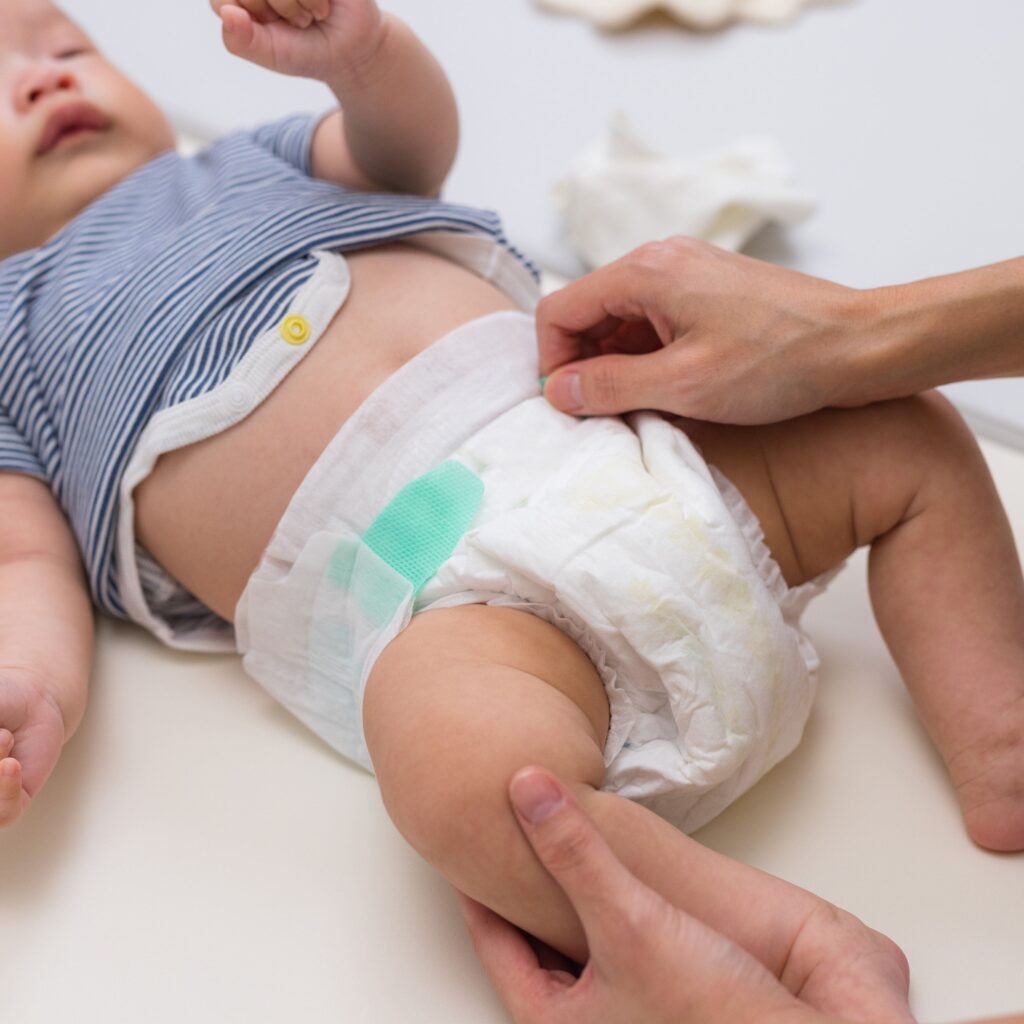
is Huggies or Pampers less toxic?
In terms of being less toxic, Huggies has stated all of their diapers are free of fragrances, phthalates, parabens, and elemental chlorine. They’ve also partnered with Terracycle to offer plastic film recycling options.
Pampers diapers are made without parabens, natural rubber latex and elemental chlorine. But only their Pure diapers are made without fragrance (and many mothers online have complained of Pampers’ strong scent).
However, Pampers’ factories are zero manufacturing waste to landfill and they use FSC certified wood pulp.
Both brands list their ingredients on their websites, so definitely read them for yourself before making a purchase. Just be mindful both brands also use colorants and printing inks to make designs and/or color change technology.
which diaper brands are safe for babies?
The diaper brands safe for babies are listed below. There’s a mix of disposable and cloth diapers, so there’s something for everyone.
However, be mindful that every baby is different and what works for one, doesn’t always work for another. For example, certain brands may fit your baby like a glove, whereas others may be too big: It’s all about experimenting and finding what works for your baby.
You can use this list as a starting point to help you choose a better, safer choice for your child. None of the brands listed here use fragrance, parabens, or other harsh chemicals.
I’ve gone ahead and highlighted some of my favorite features of each brand, but it isn’t an exhaustive list. Be sure to check out their websites for more information.
Also, if you cloth diaper, don’t forget to consider eco-friendly baby detergent brands because you’ll be doing a bit more laundry!
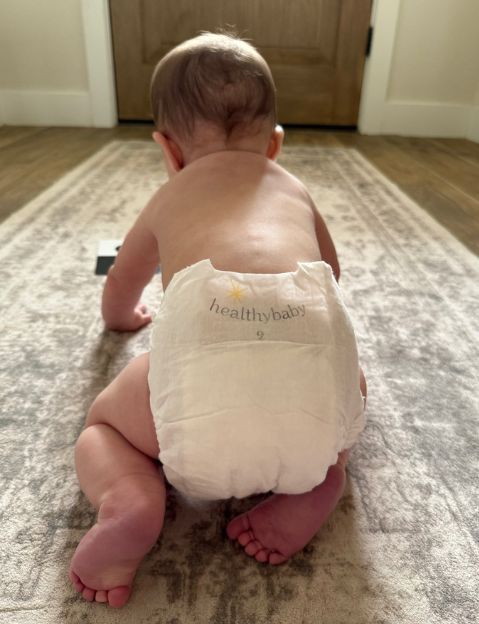
1. healthy baby
- Offers disposable and cloth diapering options
- Six sizes, not including newborn (N or N/1)
- Plant-based materials including organic cotton + FSC certified pulp
- 12 hour leak protection
- No chemical wetness indicator
- EWG certified
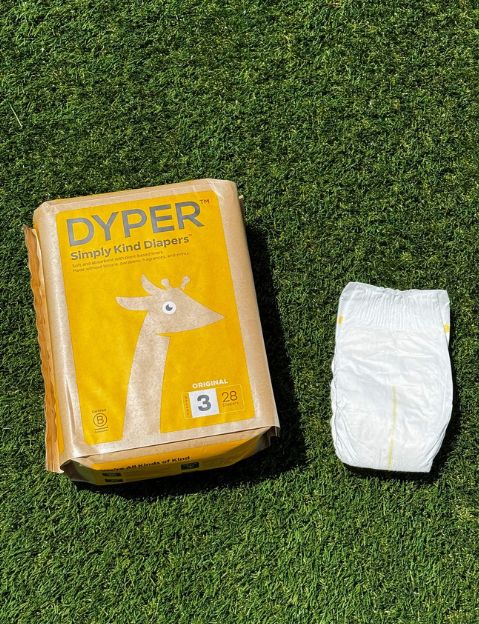
2. dyper
- Disposable diapers
- Six sizes, not including newborn (NB)
- Plant-based materials, including FSC-certified pulp
- 12-hour leak protection
- No inks, prints or dyes
- Offers REDYPER service to compost diapers through weekly pickup
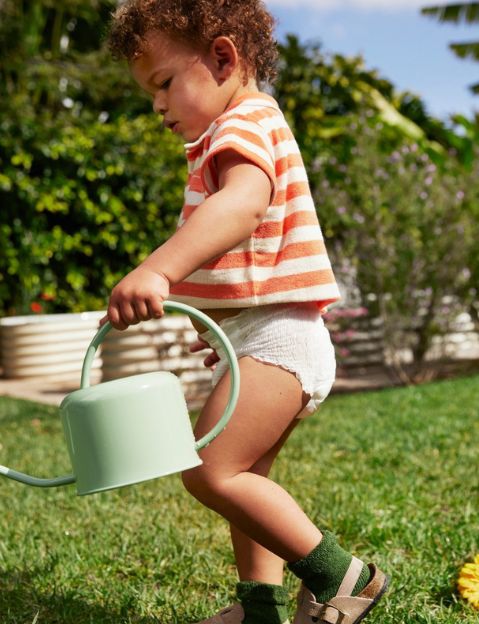
3. coterie
- Disposable diapers
- Seven sizes, not including newborn (N or N+1)
- 25% plant-based, made with wood pulp from sustainably manages forests
- 12-hour leak protection
- Wetness indicator
- Cruelty-free
- OEKO-TEX STANDARD 100 Certified
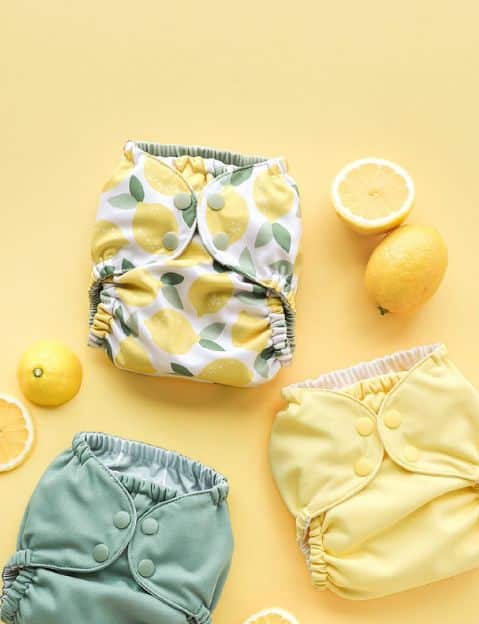
4. esembly baby
- Cloth diapers
- Two sizes, based on pounds
- Made of organic cotton + upcycled TPU
- Recommended to change an awake baby every 2-3 hours
- Wet bags sold separately to hold dirty diapers while out
- Pre-loved options to buy and sell available
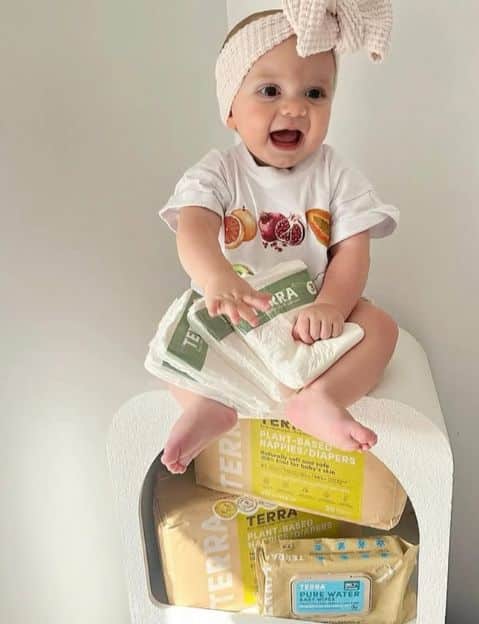
5. terra
- Disposable diapers
- Six sizes
- 85% plant-based, including FSC-certified pulp
- 12-hour leak-proof protection
- Plant-based wetness indicator
- Ink on product + packaging is food grade
- Packaging is made from recyclable kraft paper + rice
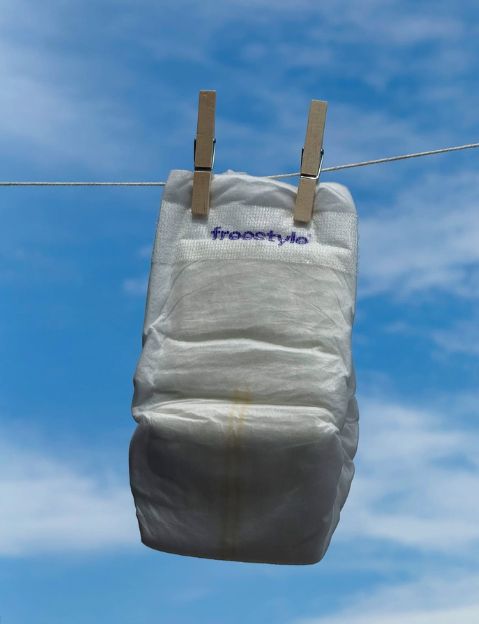
6. freestyle
- Disposable diapers
- Six sizes
- 7-layer protection for 14x better absorption
- Delivered in 1 month long supplies
- FSC certified pulp
- EWG verified
Which of these sustainable diaper options would you choose? Let me know in the comments!
The post 6 Best Non Toxic Diapers For Babies appeared first on Going Zero Waste.
Green Living
The Many Layers of Personal Style
Personal style is a dance between dualities: fashion as art and fashion as function; clothing as self-expression and clothing for our circumstances.
Style is a medium for communication and self-expression, yes. But it’s also shaped by the environments and requirements around us, from workplace dress codes to city cultures, climates, and specific occassions.
In last Saturday’s workshop, where we talked about how to remix what you already have in your closet, attendees shared a common challenge:
How do you balance your personal style expression while dressing for the various situations and environments we operate in?
“I’ve found above all else my style is highly influenced by my environment (my job, my city etc.)—sometimes it becomes about ‘fitting in’ and losing individuality”
“I find I’m too led by my day-to-day lifestyle. I WFH and so often I just don’t get dressed at all.”
“There are too many applications: workout, work, at home, formal occasion.”
Style as Identity vs. Style as Communication
It’s no wonder style and getting dressed can feel so confusing.
In the personal style world, we learn to dress for who we are on the inside. And then we see the style rules in fashion media: here’s how to dress for this season, this dress code, this city.
And in our real lives, we have real dress codes we might have to follow, whether for a workplace or a wedding.
But what if all those sides conflict?
- If my style words are “casual” or “sporty” but I’m in a workplace 40+ hours a week that requires business formal, where does that leave my personal style?
- If I love vibrant and artsy looks, but I live in a city full of neutrals, what do I wear?
It’s no surprise it feels… complicated.
Here’s my take.
We’re Not One-Dimensional — Neither is Our Style
Sometimes I want to disconnect and live in cottage in the mountains, surrounded by more trees than people. Other days I dream of having an apartment in the center of Paris where I see more people in a day than live in my hometown.
I’m light, joyful, maybe even quirky with friends. I’m ambitious, intentional, perhaps more serious in work. There are times I feel it’s best to soften and let it go; other times it feels most aligned to be unapologetically outspoken.
We are human. We’re social creatures. We’re complex and full of contradictions.
Social media has trained us to fit people into neat boxes because “niche” is what performs in the algorithm.
In real life, though, our “authentic” selves aren’t so one-dimensional.
I’m not speaking to new networking contacts the same exact way I talk to my best friend I’ve known for years. That doesn’t mean I’m pretending to be someone else. It just means I’m showing up a bit differently depending on the context.
Similarly, our personal style doesn’t have to be expressed in one singular way.
That’s what’s beautiful about fashion! We have the opportunity to express ourselves a bit differently each and every time we get dressed.
What we wear might ebb and flow with a situation, the season, or our mood. There are common threads, but differentiators too.
Three distinctly different looks can all be authentic.
For me, personal style isn’t about being setting such rigid parameters that we can no longer embrace our multi-dimensional nature.
And there’s undoubtedly the layers of privilege at work here too. Is it safe to dress in alignment with your true identity in that particular situation? Will you be taken seriously? Could there be repercussions?
There’s a lot to untangle when it comes to what we wear.
Making Our Multi-Dimensional Style Practical
As I shared in last week’s workshops, style is many layers. The four I see it through are the vibe, the shapes, the colors & textures, and our lifestyle & values.

The aesthetic reflects your vibe, mood or style adjectives.
- For example, my vibe or adjectives are feminine, structured, grounded.
The shapes are the fits, silhouettes, and proportions you love.
- I often wear outfits with a straight silhouette or tailored fit balanced with a relaxed, flowy, or drapey element.
Colors & textures include your preferred palettes, fabrics, and the way materials feel.
- I prefer wearing natural fibers when possible. I like gold jewelry, and I feel more aligned in lower contrast looks. Lighter colors for day. Sometimes darker for evening or certain events.
The lifestyle & values element is the consideration of your actual day-to-day. What situations and environments are you dressing for? What is important to you?
- I work from home so comfort is key most of the time. I value slow fashion practices — rewearing, repairing, and supporting circular practices and sustainably-minded brands.
Once you understand these layers of your style, the next step is figuring out how to apply them in real-life situations.
Applying Your Style to the Situation
In last week’s workshops, I talked about the role of outfit templates here for various situations. What is the foundational blueprint of what you might wear to your office, working from home, in a school setting, at home, running errands, and so on?
There are opportunities to bring in the layers of your personal style in these various situations, but it does require some intentionally on the outset. Otherwise, it’s easy to fall into our old patterns or copy what others around us wear. (Even subconsciously, as fashion psychologist Shakaila Forbes-Bell has shared!)

Here’s one of my work-from-home outfit templates that balances style and situational needs:
- Blouse with feminine detail: I start with the top for Zoom calls!
- Straight-leg bottoms: this could be jeans, colorful pants, or a column skirt
- Slim shoes: the general “slim” descriptor makes it versatile across seasons
- Structured bag: an option to add polish when coworking at a café
By thinking in these various layers (vibe, shapes, colors & textures, and lifestyle & values) you can build outfits that feel authentic to you while fitting the constraints of the external situation.
What About One-Off Unique Situations?
Like this Wednesday evening, I spoke on a “Sustainable Fashion in Action” panel with Chicago Climate Connect during Sustainable Fashion Week Chicago. But the panel was also taking place at the Patagonia x Worn Wear store.
So the vibe was professional meets fashion, but also kinda casual?! And we are still in the Midwest here. I have to say, this one wasn’t easy.
But here’s the step-by-step thought process that helped me balance my style, function, and a unique-to-me context.

- I picked a foundational piece: My navy wide-leg trousers were business casual without being too formal and were practical for train travel.
- And functional accessories:My old Coach bag fits everything and my chunky Veja sneakers matched the vibe I was going for so those were the picks.
- Then a piece that brought it all together:At this point I was mixing high-contrast colors (white with navy & black) and different vibes (trousers vs. sneakers). I felt like I needed a bridge for the outfit, and this navy-striped vest tied it all together.
- Finally, some final touches: Gold jewelry made the look feel more “me”, while this cap from Abbie at The Filtery made it all feel effortless.
In the end, this outfit took a lot longer to create than a typical look.
It took longer to create than my usual outfits, but it felt just right. The combination was practical, suited my style, fit the vibe of the panel, and aligned with the weather.
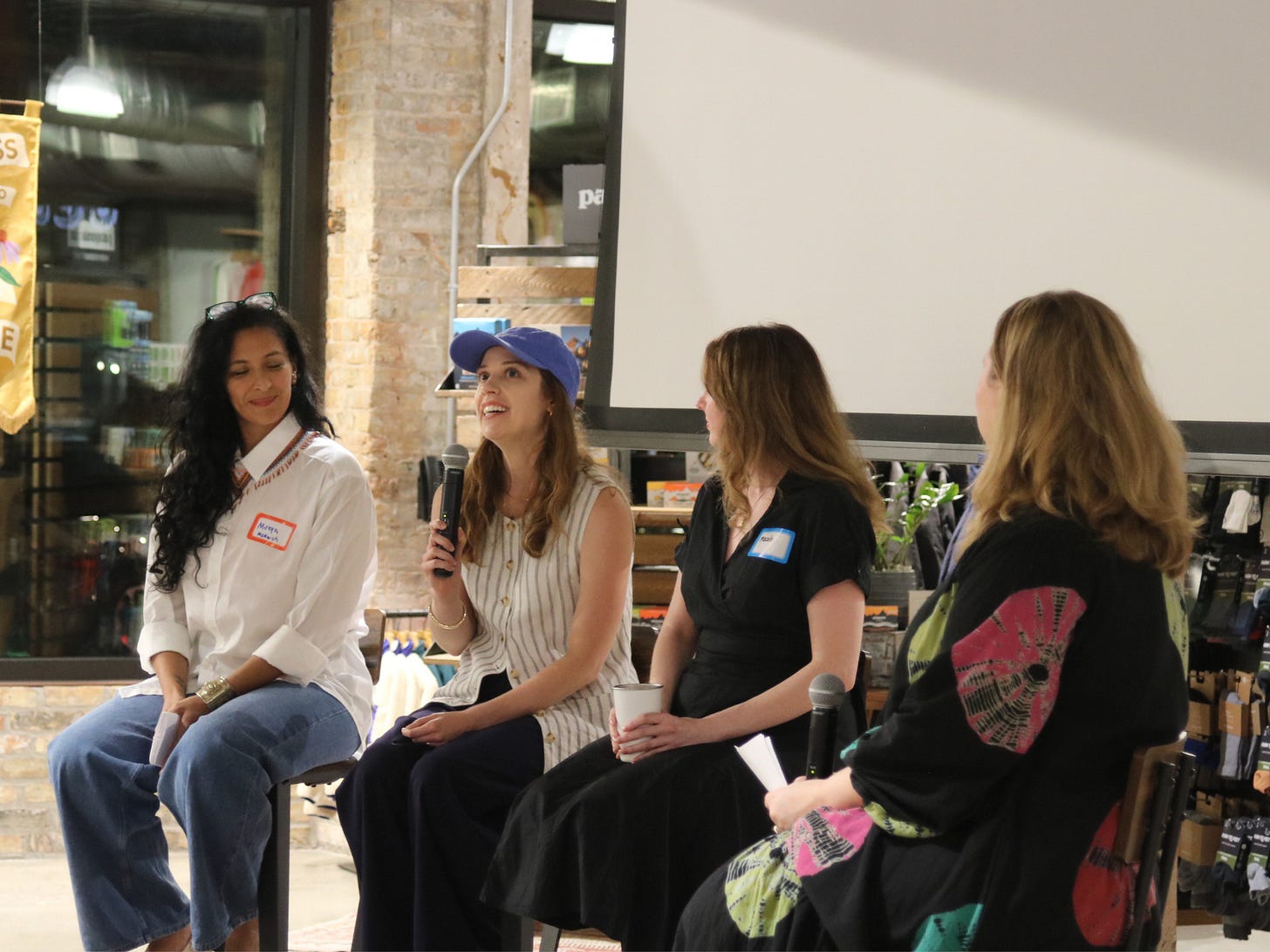
This panel outfit reminded me that style is what we wear to express ourselves, but it’s also a tool to help us navigate our lives. By thinking through these layers of personal style (vibe, shapes, colors, textures, and lifestyle needs) we can balance showing up authentically while honoring the nuances or navigating the constraints of a situation.
For me, that’s the real power of personal style.
One single outfit can’t tell the whole story of who we are. But personal style can be flexible, functional, and expressive of the many sides of our multi-dimensional nature.
So lately, more than asking “does this outfit perfectly express my full self?” I’ve been finding myself asking:
“Does this outfit help me show up in the way I want to? Does it say what I want it to say in this particular moment?“
The post The Many Layers of Personal Style appeared first on .
Green Living
You’re multi-dimensional. So is your style.
Personal style is a dance between dualities: fashion as art and fashion as function; clothing as self-expression and clothing for our circumstances.
Style is a medium for communication and self-expression, yes. But it’s also shaped by the environments and requirements around us, from workplace dress codes to city cultures, climates, and specific occassions.
In last Saturday’s workshop, where we talked about how to remix what you already have in your closet, attendees shared a common challenge:
How do you balance your personal style expression while dressing for the various situations and environments we operate in?
“I’ve found above all else my style is highly influenced by my environment (my job, my city etc.)—sometimes it becomes about ‘fitting in’ and losing individuality”
“I find I’m too led by my day-to-day lifestyle. I WFH and so often I just don’t get dressed at all.”
“There are too many applications: workout, work, at home, formal occasion.”
Style as Identity vs. Style as Communication
It’s no wonder style and getting dressed can feel so confusing.
In the personal style world, we learn to dress for who we are on the inside. And then we see the style rules in fashion media: here’s how to dress for this season, this dress code, this city.
And in our real lives, we have real dress codes we might have to follow, whether for a workplace or a wedding.
But what if all those sides conflict?
- If my style words are “casual” or “sporty” but I’m in a workplace 40+ hours a week that requires business formal, where does that leave my personal style?
- If I love vibrant and artsy looks, but I live in a city full of neutrals, what do I wear?
It’s no surprise it feels… complicated.
Here’s my take.
We’re Not One-Dimensional — Neither is Our Style
Sometimes I want to disconnect and live in cottage in the mountains, surrounded by more trees than people. Other days I dream of having an apartment in the center of Paris where I see more people in a day than live in my hometown.
I’m light, joyful, maybe even quirky with friends. I’m ambitious, intentional, perhaps more serious in work. There are times I feel it’s best to soften and let it go; other times it feels most aligned to be unapologetically outspoken.
We are human. We’re social creatures. We’re complex and full of contradictions.
Social media has trained us to fit people into neat boxes because “niche” is what performs in the algorithm.
In real life, though, our “authentic” selves aren’t so one-dimensional.
I’m not speaking to new networking contacts the same exact way I talk to my best friend I’ve known for years. That doesn’t mean I’m pretending to be someone else. It just means I’m showing up a bit differently depending on the context.
Similarly, our personal style doesn’t have to be expressed in one singular way.
That’s what’s beautiful about fashion! We have the opportunity to express ourselves a bit differently each and every time we get dressed.
What we wear might ebb and flow with a situation, the season, or our mood. There are common threads, but differentiators too.
Three distinctly different looks can all be authentic.
For me, personal style isn’t about being setting such rigid parameters that we can no longer embrace our multi-dimensional nature.
And there’s undoubtedly the layers of privilege at work here too. Is it safe to dress in alignment with your true identity in that particular situation? Will you be taken seriously? Could there be repercussions?
There’s a lot to untangle when it comes to what we wear.
Making Our Multi-Dimensional Style Practical
As I shared in last week’s workshops, style is many layers. The four I see it through are the vibe, the shapes, the colors & textures, and our lifestyle & values.

The aesthetic reflects your vibe, mood or style adjectives.
- For example, my vibe or adjectives are feminine, structured, grounded.
The shapes are the fits, silhouettes, and proportions you love.
- I often wear outfits with a straight silhouette or tailored fit balanced with a relaxed, flowy, or drapey element.
Colors & textures include your preferred palettes, fabrics, and the way materials feel.
- I prefer wearing natural fibers when possible. I like gold jewelry, and I feel more aligned in lower contrast looks. Lighter colors for day. Sometimes darker for evening or certain events.
The lifestyle & values element is the consideration of your actual day-to-day. What situations and environments are you dressing for? What is important to you?
- I work from home so comfort is key most of the time. I value slow fashion practices — rewearing, repairing, and supporting circular practices and sustainably-minded brands.
Once you understand these layers of your style, the next step is figuring out how to apply them in real-life situations.
Applying Your Style to the Situation
In last week’s workshops, I talked about the role of outfit templates here for various situations. What is the foundational blueprint of what you might wear to your office, working from home, in a school setting, at home, running errands, and so on?
There are opportunities to bring in the layers of your personal style in these various situations, but it does require some intentionally on the outset. Otherwise, it’s easy to fall into our old patterns or copy what others around us wear. (Even subconsciously, as fashion psychologist Shakaila Forbes-Bell has shared!)
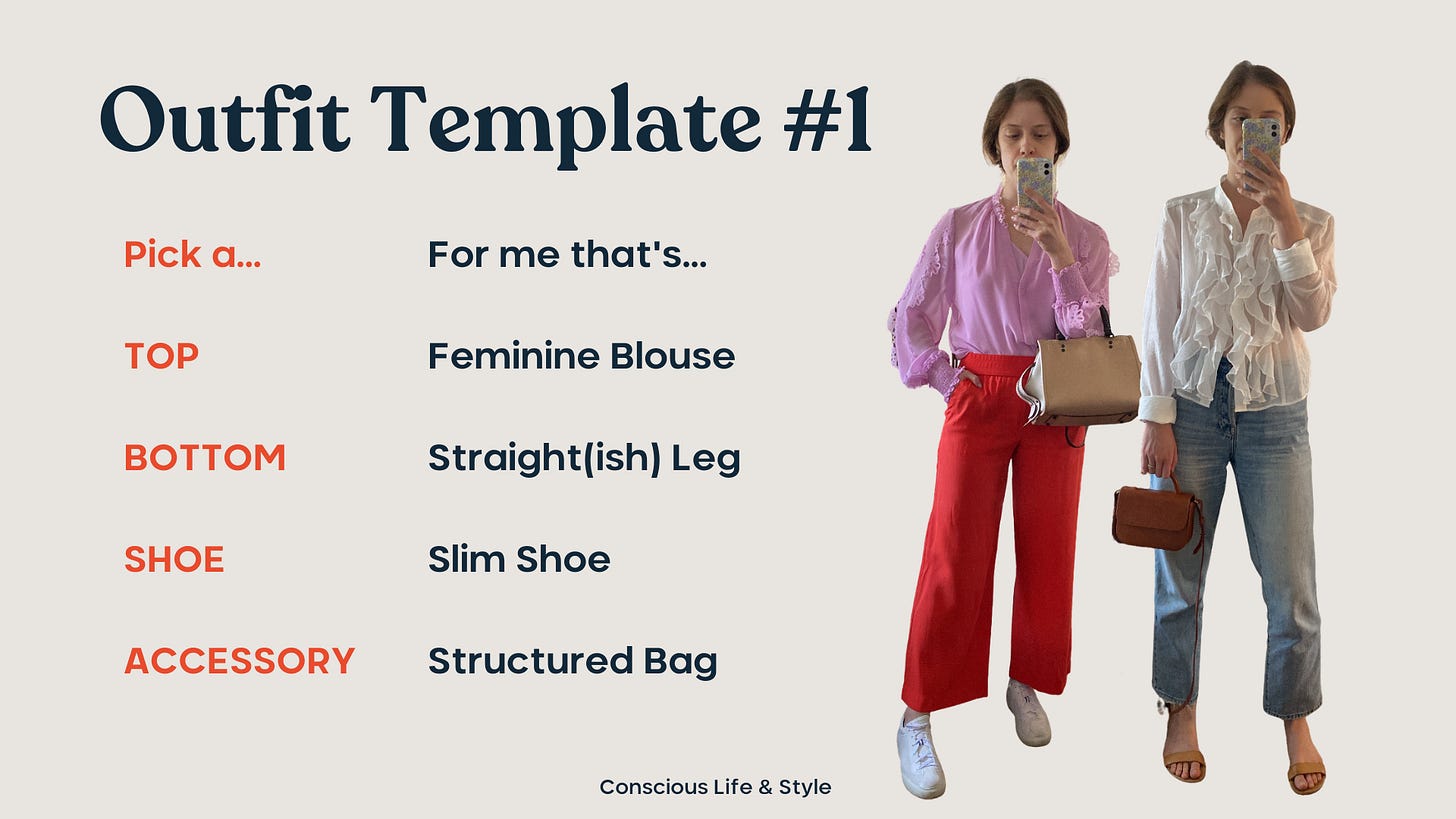
Here’s one of my work-from-home outfit templates that balances style and situational needs:
- Blouse with feminine detail: I start with the top for Zoom calls!
- Straight-leg bottoms: this could be jeans, colorful pants, or a column skirt
- Slim shoes: the general “slim” descriptor makes it versatile across seasons
- Structured bag: an option to add polish when coworking at a café
By thinking in these various layers (vibe, shapes, colors & textures, and lifestyle & values) you can build outfits that feel authentic to you while fitting the constraints of the external situation.
What About One-Off Unique Situations?
Like this Wednesday evening, I spoke on a “Sustainable Fashion in Action” panel with Chicago Climate Connect during Sustainable Fashion Week Chicago. But the panel was also taking place at the Patagonia x Worn Wear store.
So the vibe was professional meets fashion, but also kinda casual?! And we are still in the Midwest here. I have to say, this one wasn’t easy.
But here’s the step-by-step thought process that helped me balance my style, function, and a unique-to-me context.
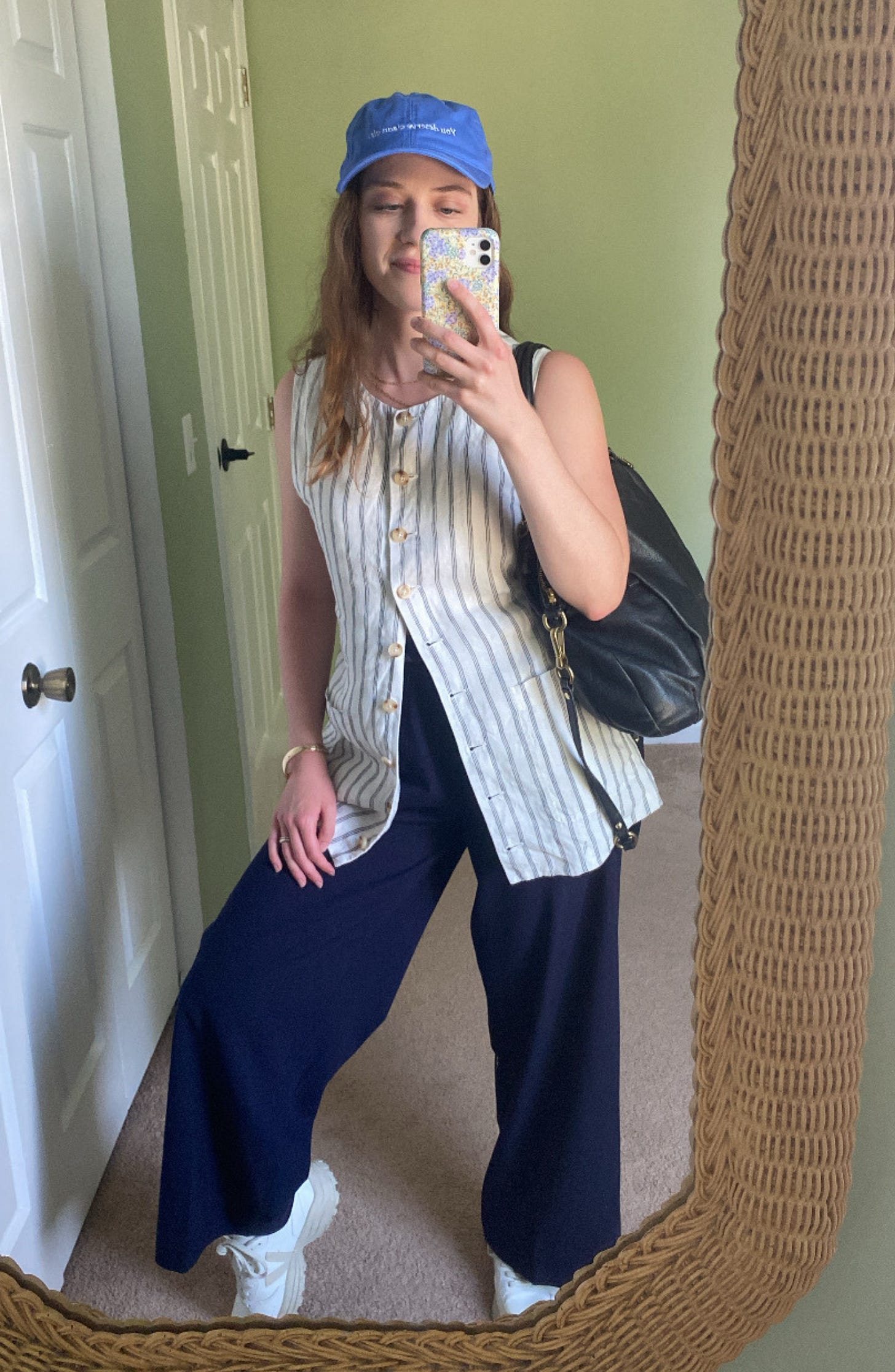
- I picked a foundational piece: My navy wide-leg trousers were business casual without being too formal and were practical for train travel.
- And functional accessories:My old Coach bag fits everything and my chunky Veja sneakers matched the vibe I was going for so those were the picks.
- Then a piece that brought it all together:At this point I was mixing high-contrast colors (white with navy & black) and different vibes (trousers vs. sneakers). I felt like I needed a bridge for the outfit, and this navy-striped vest tied it all together.
- Finally, some final touches: Gold jewelry made the look feel more “me”, while this cap from Abbie at The Filtery made it all feel effortless.
In the end, this outfit took a lot longer to create than a typical look.
It took longer to create than my usual outfits, but it felt just right. The combination was practical, suited my style, fit the vibe of the panel, and aligned with the weather.

This panel outfit reminded me that style is what we wear to express ourselves, but it’s also a tool to help us navigate our lives. By thinking through these layers of personal style (vibe, shapes, colors, textures, and lifestyle needs) we can balance showing up authentically while honoring the nuances or navigating the constraints of a situation.
For me, that’s the real power of personal style.
One single outfit can’t tell the whole story of who we are. But personal style can be flexible, functional, and expressive of the many sides of our multi-dimensional nature.
So lately, more than asking “does this outfit perfectly express my full self?” I’ve been finding myself asking:
“Does this outfit help me show up in the way I want to? Does it say what I want it to say in this particular moment?“
The post You’re multi-dimensional. So is your style. appeared first on .
-
Climate Change2 years ago
Spanish-language misinformation on renewable energy spreads online, report shows
-
Climate Change3 months ago
Guest post: Why China is still building new coal – and when it might stop
-
Climate Change Videos2 years ago
The toxic gas flares fuelling Nigeria’s climate change – BBC News
-

 Greenhouse Gases1 year ago
Greenhouse Gases1 year ago嘉宾来稿:满足中国增长的用电需求 光伏加储能“比新建煤电更实惠”
-
Greenhouse Gases3 months ago
Guest post: Why China is still building new coal – and when it might stop
-

 Climate Change1 year ago
Climate Change1 year ago嘉宾来稿:满足中国增长的用电需求 光伏加储能“比新建煤电更实惠”
-

 Carbon Footprint2 years ago
Carbon Footprint2 years agoUS SEC’s Climate Disclosure Rules Spur Renewed Interest in Carbon Credits
-
Renewable Energy3 months ago
US Grid Strain, Possible Allete Sale

















